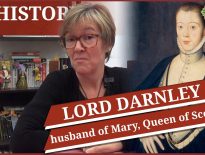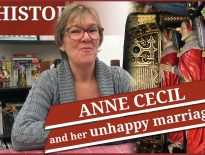Today, 6th December is the Feast of St Nicholas, or St Nicholas of Myra, the 4th century Bishop of Myra. In medieval and Tudor times, it was the traditional day for the election of a boy bishop would undertake all of the duties of a bishop from the 6th December until 28th December, Childermas (Holy Innocents' Day).
You can find out about the tradition of Boy Bishop, and how and why Henry VIII put an end to it, and how it's been revived today, in today's talk from Claire Ridgway, founder of the Tudor Society.
Link to order of service for Boy Bishop ceremony - https://www.stnicholascenter.org/how-to-celebrate/resources/liturgical/orders/boy-bishop-ceremonies/boy-bishop-hereford
Also on this day in history:
- 1549 – Death of John Wakeman (born Wiche), Abbot of Tewkesbury and Bishop of Gloucester, in Forthampton, Gloucestershire. He took the name Wakeman when he surrendered his monastery to the commissioners in 1540.
- 1555 – Death of Thomas Cottisford, clergyman, translator and reformer, at Frankfurt while in exile in Mary I's reign. In Edward VI's reign, Cottisford published a translation of Zwingli's confession of faith.
- 1573 – Death of Sir Hugh Paulet, soldier and administrator, at Hinton St George in Somerset. He was buried in the parish church there. Paulet was one of Henry VIII's executors and served Edward VI as Captain of Jersey and Governor of Mont Orgueil Castle. In Mary I's reign, he was made Vice-President of the Welsh marches, and in Elizabeth I's reign he served as a special adviser to Ambrose Dudley, Earl of Warwick, at Le Havre.
Transcript:
Today, 6th December is the Feast of St Nicholas, or St Nicholas of Myra, the 4th century Bishop of Myra.
St Nicholas is the patron saint of children, as well as sailors, merchants, archers, repentant thieves, brewers, pawnbrokers and students.
Today, we associate St Nicholas with Santa Claus, the gentleman who comes down chimneys late on Christmas Eve to deliver presents to those who’ve been good, and that does come from the idea that St Nicholas was generous to the poor.
However, in medieval and Tudor times, there was no Santa Claus, and St Nicholas was remembered on his feat day, 6th December, when it was traditional for a choirboy to be chosen as “Boy Bishop”. This young bishop would dress up as bishop, lead processions around communities, collect money for the parish funds, and even lead services and preach the sermon from 6th December until Childermas, or Holy Innocents’ Day on 28th December. According to records, on 7th December 1229, the day after his election, a boy bishop said vespers in the presence of King Edward I at Heton, near Newcastle upon Tyne.
According to the Gospel of Matthew, Jesus Christ had said “Suffer little children to come unto me, and forbid them not: for of such is the kingdom of God. Verily I say unto you, Whosoever shall not receive the kingdom of God as a little child shall in no wise enter therein”, so this election of a boy as bishop was a reminder of this teaching.
In July 1542, following the break with Rome and the Reformation, King Henry VIII banned what he saw as a superstitious and childish practice by proclamation, saying that:
“Whereas here-tofore diverse and many superstitions and childish observances have been used, and yet to this day are observed and kept, in many and sundry parts of this realm, as upon Saint Nicholas, Saint Catherine, Saint Clement, the Holy Innocents, and such like, children be strangely decked and apparelled to counterfeit priests, bishops, and women, and so be led with songs and dances from house to house, blessing the people and gathering of money; and boys do sing mass and preach in the pulpit, with such other unfitting and inconvenient usages, rather to the derision than any true glory of God, or honour of his saints: The King’s Majesty therefore, minding nothinge so muche as to advance the true glory of God without vain superstition, willeth and commandeth that from henceforth all such superstitious observations be left and clearly extinguished throughout his realms and dominions, for asmuch as the same doth resemble rather the unlawful superstition of gentility, than the pure and sincere religion of Christ.”
The ban continued into the reign of his son, King Edward VI, but following the reconciliation with Rome, Mary I brought back the tradition. In December 1556, Diarist, merchant-tailor and London citizen Henry Machyn recorded “The 5th of December (1556) was Saint Nicholas’ even, and Saint Nicholas went abroad in most parts of London singing after the old fashion, and was received with many good people into their houses, and had much cheer as ever they had in many places.”
However, not everybody was happy about the return of this tradition, with martyrologist John Foxe recording that a woman named Gertrude Crockhay, who lived in the parish of St Katherine’s, near the Tower of London, refused to recognise and let into her house St Nicholas. When asked why, she stated that the visitor was her neighbour’s child, not Saint Nicholas, for Saint Nicholas was in heaven, and that she was afraid of the visitor cutting her purse, i.e. stealing from her.
The tradition of boy bishop was once again abolished in the reign of the Protestant Queen Elizabeth I.
However, it has been revived in some churches and cathedrals in the UK. Hereford Cathedral was the first English place of worship to revive the tradition and did so in 1973. The St Nicholas Center website explains that:
“This annual ceremony is a successor to a service that developed sometime in the thirteenth century. The climax of the ceremony takes place during the singing of the canticle Magnificat. As the choir sings the words He hath put down the mighty from their seat, the Boy Bishop displaces the Bishop of Hereford from his episcopal chair.”
Salisbury Cathedral have a chorister bishop now, rather than boy bishop, so that girls can also be chosen. This year, 2019, the special ceremony is taking place on Sunday 8th December. The chorister bishop becomes bishop for the one evening delivering their very own sermon from the bishop’s chair complete with robes, mitre and staff, while the real bishop is bareheaded. The Salisbury Cathedral website explains:
“The topsy-turvy Chorister Bishop ceremony echoes the Medieval practice of holding festivals in which the ‘high’ became ‘low’ and vice versa. In this case, the elected Chorister Bishop was in office from St Nicholas Day until Holy Innocents Day at the end of December, empowered to make decisions on the disposal of benefices (or church appointments) that fell vacant within this period, as well as presiding over all services.”
I love that an age-old tradition is still taking place today.



Leave a Reply